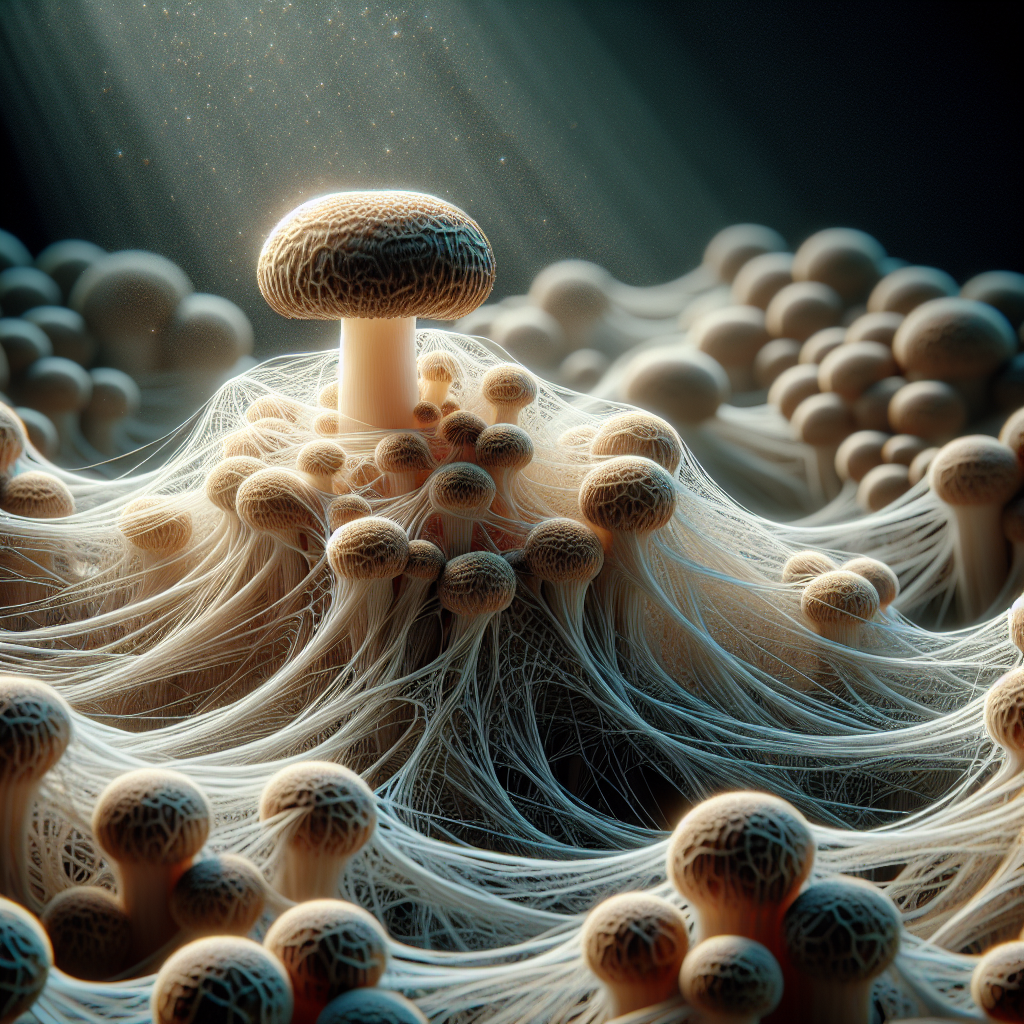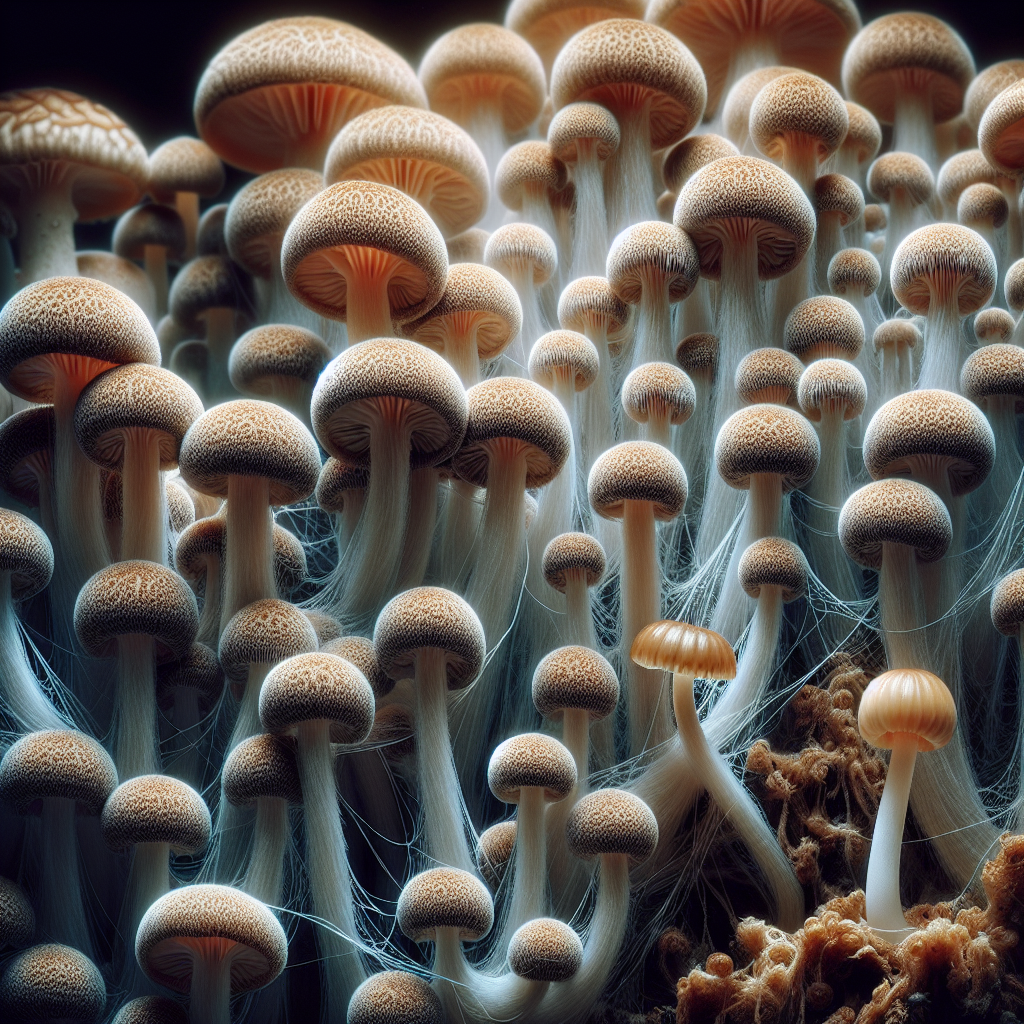In the fascinating world of fungi, “The Magic of Shiitake Mycelium” magnificently transports you through the captivating process and therapeutic benefits of Shiitake mycelium. Shiitake mushrooms, widely recognized for their culinary uses, indeed, bring more on the plate than you may realize. This article explores the lifecycle of the mushroom, specifically focusing on the significant yet less recognized mycelium stage. Furthermore, it illuminates how the mycelial network thrives and its profound implications on your health and the environment at large. As you embark on this journey, you’ll gain a newfound appreciation for these fungal wonders and their intriguing subterranean life.
Understanding the Shiitake Mushroom
Description and Lifecycle of Shiitake Mushrooms
Shiitake mushrooms, scientifically known as Lentinula edodes, are one of the most popular culinary mushrooms worldwide. They are characterized by their umami flavor and fleshy, meaty texture. The lifecycle of Shiitake mushrooms initiates as spores that germinate to form mycelium. This mycelium continues to grow, ultimately forming a dense mat known as a mycelial mat. When provided with the right environmental conditions, this mat gives rise to mushroom fruit bodies, which mature and produce spores, thereby completing the lifecycle.
Regions Where Shiitake Mushrooms Naturally Occur
Originally, Shiitake mushrooms are native to East Asia, naturally occurring in the forests of China, Japan, Korea, and other neighboring countries. They grow predominantly on decaying hardwood trees such as oak, chestnut, maple, or beech.
Historical and Cultural Use of Shiitake Mushrooms
Shiitake mushrooms carry a rich historical and cultural significance. In ancient times in Asia, especially in China and Japan, Shiitake mushrooms were revered for their medicinal properties. They were believed to boost the immune system, maintain cardiovascular health, and even possess anticancer properties. Their cultural use extends beyond their medicinal value as they are integral to various culinary traditions in Asia due to their unique flavor and texture.
Demystifying the Term Mycelium
Defining Mycelium and Its Role in Fungi
Mycelium is an integral part of fungi, often described as the vegetative part of a fungus, consisting of a network of fine white filaments called hyphae. It serves as the primary system for nutrient uptake from the environment and plays an essential role in the growth and development of the fungus.
The Growth Process of Mycelium
The growth process of mycelium begins with spore germination. These germinated spores develop thread-like structures that continue to grow and branch out, forming the mycelium. The mycelium grows, consuming nutrients from the substrate, and under favorable conditions, gives rise to the fruiting body of the fungus or the mushroom.
The Ecological Importance of Mycelium
Mycelium plays a crucial role in ecosystem functions. They are vital in decomposition processes where they break down organic material, recycling vital nutrients and contributing to soil fertility. Furthermore, they form symbiotic relationships with plants, aiding in nutrient and water absorption.

The Shiitake Mycelium Magic
The Connection between Shiitake Mushrooms and Mycelium
The Shiitake mushroom and its mycelium are heavily intertwined. The mycelium serves as the growth and developmental stage for the Shiitake mushroom. In other words, the mushroom fruit body, which we consume, is the reproductive structure that emerges from the mycelium.
The Unique Characteristics of Shiitake Mycelium
Shiitake mycelium is unique in its resilience and adaptability. It has the unrivaled ability to break down a wide range of organic materials. Moreover, it has been observed to possess certain bioactive compounds, such as polysaccharides, lipids, and other secondary metabolites, some of which are unique to the Shiitake variety.
Illustrating the Growth Process of Shiitake Mycelium
Shiitake mycelium begins its growth process from a Shiitake spore. Once germinated, the spore develops hyphae, which branches out forming a mycelial network. This mycelial network then grows, consuming nutrients from its surroundings, and eventually gives rise to Shiitake mushrooms under the right environmental conditions.
The Nutritional Composition of Shiitake Mycelium
Covering the Main Nutrients Found in Shiitake Mycelium
Shiitake mycelium is a powerhouse of nutrients. It is rich in dietary fiber, proteins, and essential amino acids. It also contains various vitamins, especially B vitamins, and essential minerals like copper, selenium, and manganese.
Comparison of Nutritional Content between Shiitake Mycelium and Shiitake Mushrooms
While both Shiitake mycelium and Shiitake mushrooms are nutritionally potent, there are some differences in their nutritional profile. Generally, the mycelium tends to have a higher concentration of certain bioactive compounds, such as beta-glucans, compared to the fruiting body or the actual mushroom.
The Vitamins, Minerals and Antioxidants in Shiitake Mycelium
Shiitake mycelium is rich in vitamins, especially B vitamins like niacin, pantothenic acid, and vitamin B12. It also contains essential minerals, including zinc, iron, and magnesium. Furthermore, it is brimming with antioxidants that are beneficial for overall health.

The Health and Medicinal Benefits of Shiitake Mycelium
Understanding the Medicinal Properties of Shiitake Mycelium
Shiitake mycelium is known for its medicinal properties due to the presence of an array of bioactive compounds. It exhibits antiviral, antibacterial, and antitumor capabilities. Also, it has been associated with reducing heart disease risks and boosting the immune response.
Using Shiitake Mycelium in Traditional Asian Medicine
In traditional Asian medicine, Shiitake mycelium has been employed for its medicinal benefits for centuries. It has been used to bolster the immune system, lower blood cholesterol levels, and even to treat cancer.
Modern Medical Research on Shiitake Mycelium
Modern medical research continues to explore the potential health benefits of Shiitake mycelium. Some promising areas of research include its use as an immune modulator, its potential antitumor properties, and its role in promoting cardiovascular health.
How to Cultivate Shiitake Mycelium
The Importance of Sterile Conditions in Mycelium Cultivation
Sterility is crucial in the cultivation of Shiitake mycelium, as it prevents the contamination of the culture by bacteria, molds, or other fungi. This helps preserve the purity of the mycelium and ensures a healthy and thriving growth culture.
Choosing the Best Substrate for Shiitake Mycelium
Selecting the right substrate is another crucial aspect of mycelium cultivation. Shiitake mycelium thrives well on hardwood substrates such as logs, wood chips or sawdust. However, it can also adapt well to substrates made from cereal grains or straw.
Harvesting and Storing Shiitake Mycelium
The proper harvesting and storing of Shiitake mycelium is pivotal to maintaining its nutritional and bioactive properties. Mature mycelium should be harvested carefully, dried quickly to maintain its potency, and then stored in an airtight container in a cool, dry place.
Commercial and Industrial Uses of Shiitake Mycelium
Using Shiitake Mycelium in Food Production
Shiitake mycelium brings a unique flavor and texture to food, making it valuable in food production. It can be used as a meat substitute in vegan and vegetarian products due to its savory taste and meat-like texture.
Shiitake Mycelium in Cosmetics and Skin Care Products
The skin-benefiting properties of Shiitake mycelium, including its potent antioxidants and bioactive compounds, make it a useful ingredient in cosmetics and skincare products. It is known for promoting skin health, combating skin aging, and offering protection against environmental stressors.
Innovative Industrial Applications of Shiitake Mycelium
Beyond cosmetics and food, Shiitake mycelium has innovative industrial applications. These include the production of packaging materials, construction materials, and even clothing. This is largely due to its inherent resilience, adaptability, and capacity to utilize a broad spectrum of resources.
Culinary Uses of Shiitake Mushrooms and Mycelium
Incorporating Shiitake Mycelium into Various Dishes
Shiitake mycelium can be added to various dishes, enhancing the flavor and nutritional content. It can be used in soups, stir-fries, salads, and more. Its umami flavor pairs well with other ingredients, and it can also be used as a seasoning.
Pairing Shiitake Mycelium with Other Ingredients
When it comes to pairing Shiitake mycelium with other foods, consider pairing it with ingredients that complement its savory, umami flavor. This includes elements such as garlic, onions, soy sauce, and a variety of herbs and spices.
Recipes Using Shiitake Mycelium
There are countless recipes where Shiitake mycelium can add depth and nutrition. Considering trying Shiitake mycelium in dishes like mushroom risotto, mushroom soup, or in a savory stir-fry. Its unique flavor also lends itself well to sauces and gravies.
Potential Risks and Drawbacks of Using Shiitake Mycelium
Understanding the Allergic Reactions to Shiitake Mycelium
While Shiitake mycelium is generally safe for consumption, some individuals may develop an allergic reaction. Symptoms may include skin rash, itching, or difficulty breathing, which usually occur after consuming raw or undercooked Shiitake.
The Impact of Overconsumption of Shiitake Mycelium
While Shiitake mycelium is beneficial to health, overconsumption could potentially cause digestive distress, including bloating and diarrhea. Also, certain bioactive compounds present in high amounts might interact with specific medications.
Precautions to Take When Using Shiitake Mycelium
When using Shiitake mycelium, it’s essential to cook it thoroughly to avoid potential allergic reactions. Also, if you are pregnant, breastfeeding, or have a medical condition, it’s always advisable to consult with a healthcare provider before introducing Shiitake mycelium into your diet.
The Future of Shiitake Mycelium
Predicting Future Trends in Shiitake Mycelium Cultivation
With an increasing emphasis on sustainability and the growing awareness of the health benefits of Shiitake mycelium, its cultivation is expected to expand. We might see the adoption of more advanced cultivation techniques to optimize yield and bioactive constituent production.
Shiitake Mycelium and Sustainable Farming Practices
Shiitake mycelium cultivation leans towards sustainability as it promotes the circular use of resources. Furthermore, it contributes to soil fertility and reduces dependence on chemical fertilizers, aligning itself well with sustainable farming practices.
Potential New Uses for Shiitake Mycelium in Medicine and Beyond
As we continue exploring the myriad of health benefits and uses of Shiitake mycelium, we can anticipate new applications in medicine and beyond. This could include innovative use in pharmaceuticals, functional foods, and bio-materials to name a few.
